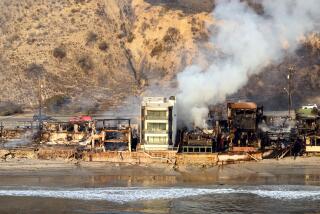Army Corps of Engineers surveys damage from Palisades, Eaton fires before cleanup begins

- Share via
As firefighters start to get the upper hand on the Eaton and Palisades fires, the focus now shifts to clearing debris from the thousands of destroyed or heavily damaged homes, an effort complicated by hazardous materials and toxic ash.
The process began Friday when a small convoy with the U.S. Army Corps of Engineers surveyed a swath of charred properties along the Pacific Coast Highway in Malibu.
Debris cleanup for the roughly 12,000 private parcels charred by the fires will be free to impacted residents, but the Army Corps of Engineers has yet to determine how it will complete the momentous task.
Inspections of fire-damaged homes are less than halfway done. Here’s how to check your home’s status
L.A. County officials have been assessing homes in the path of the Palisades and Eaton fires. Maps, still in progress, have photos of the homes and damage estimates.
As members of the Army Corps of Engineers toured properties along Pacific Coast Highway, they saw the chimneys and door frames that remained of the burned beachside homes. The tour through the damaged neighborhood was somber and matter-of-fact as the officials assessed the work that needed to be done.
They remarked about sea walls and metal, about utilities and the logistics of bringing in contractors to the site. Could the sites be cleared with heavy machinery or would workers need to use hand tools? All these questions floated in the air as the officials in army fatigues stood along the once-picturesque coast.
The proximity to the ocean means the operation could become more complex. Contractors who take on the job will need to tamp down any debris by spraying it with water because the ash likely contains heavy metals and other compounds, said Debris Subject Matter Expert Cory Koger with the Army Corps of Engineers.
The convoy of Army Corps of Engineers members planned to visit other neighborhoods destroyed by the Palisades fire.
“You look out at it and it’s just devastation,” said Maj. General Jason Kelly, deputy commanding general for civil works and emergency operations with the Corps.
Koger called the scene heartbreaking and personal for several members with the Corps because three families from the Corps lost their homes in the fires.
Each site could take two to four days to clear out, Col. Eric Swenson with the Army Corps of Engineers said during the tour. He referred to work carried out by the Army Corps of Engineers after the devastating 2023 wildfires in Maui.
The cleanup would be a two-step process, starting with the Environmental Protection Agency clearing out hazardous materials. For the second step, Los Angeles County will need to secure permission from the property owners to have the rest of the debris hauled out, Swenson said.
The EPA will need to clear any hazardous materials, such as batteries, paints and automotive oils, and store them for proper disposal. The first phase of the large-scale clean-up operation carried out by the EPA will be complicated by the fact that many electric vehicles with batteries burned in the fires along with solar panel batteries.
“There’s gonna be a lot of electric vehicles, so (the EPA) need to properly handle those as well,” Koger said. “This is a new kind of evolving fire impact.”
The next step will be to assess the property and understand how the property looked before the fires. Residents who sign up for the debris removal program should contact their home insurance provider to determine if it could affect their policy, Swenson said.
A pulmonary doctor is warning survivors to wait, if they can, to visit their fire-damaged homes. If they do go into a burn zone, they should take precautions.
“Debris removal is not complicated, but it is complex,” Swenson said earlier in the week during a press briefing with Los Angeles County officials. “We will work with communities and residents every step of the way so they understand what they’re signing up for, and they understand the service that they’re going to receive and the benefit we’ll provide them in their quest to rebuild their lives and livelihoods here on their properties.”
The operation in Southern California would involve clearing the property down to the foundation and scraping off six inches of soil from around the foundation to clear ash from the fire.
More to Read
Sign up for Essential California
The most important California stories and recommendations in your inbox every morning.
You may occasionally receive promotional content from the Los Angeles Times.













